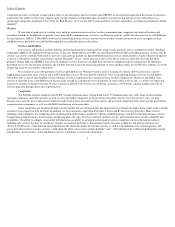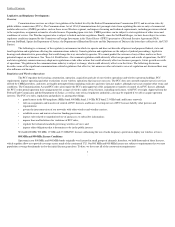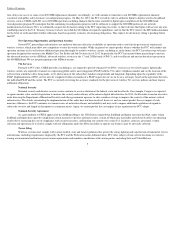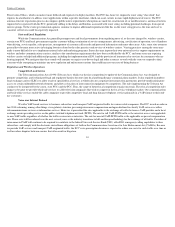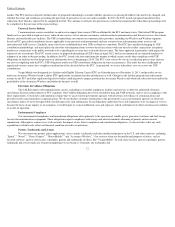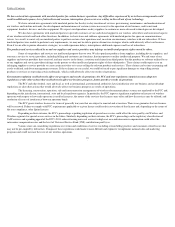Sprint - Nextel 2013 Annual Report Download - page 18
Download and view the complete annual report
Please find page 18 of the 2013 Sprint - Nextel annual report below. You can navigate through the pages in the report by either clicking on the pages listed below, or by using the keyword search tool below to find specific information within the annual report.
Table of Contents
and may impair our operating flexibility and our ability to compete effectively, particularly with respect to competitors that are less leveraged.
The debt ratings for our outstanding notes are currently below the "investment grade" category, which results in higher borrowing costs than
investment grade debt as well as reduced marketability of our debt. Our debt ratings could be further downgraded for various reasons, including if we incur
significant additional indebtedness or if we do not generate sufficient cash from our operations, which would likely increase our future borrowing costs and
could adversely affect our ability to obtain additional capital.
An unsecured revolving bank credit facility and an unsecured loan agreement with Export Development Canada (EDC Agreement) requires us to
maintain a certain covenant leverage ratio. If we do not continue to satisfy this required ratio or receive waivers from our lenders, we will be in default under the
revolving bank credit facility and the EDC Agreement, which could trigger defaults under our other debt obligations, which in turn could result in the maturities
of certain debt obligations being accelerated. In addition to the covenants in the revolving bank credit facility, the EDC Agreement and our secured equipment
credit facility, certain indentures governing notes issued by our subsidiaries limit, among other things, our ability to incur additional debt, pay dividends, create
liens and sell, transfer, lease or dispose of assets. Such restrictions could adversely affect their ability to access the capital markets or engage in certain
transactions.
The trading price of our common stock has been and may continue to be volatile and may not reflect our actual operations and performance.
Market and industry factors may adversely impact the market price of our common stock, regardless of our actual operations and performance. Stock
price volatility and sustained decreases in our share price could subject our stockholders to losses and may adversely impact our ability to issue equity. The
trading price of our common stock has been, and may continue to be, subject to fluctuations in response to various factors, some of which are beyond our
control, including, but not limited to:
16
•
quarterly announcements and variations in our results of operations or those of our competitors, either alone or in comparison to analysts'
expectations or prior company estimates, including announcements of subscriber counts, rates of churn, and operating margins that would
result in downward pressure on our stock price;
•
the cost and availability or perceived availability of additional capital and market perceptions relating to our access to capital;
•
announcements by us or our competitors, or market speculation, of acquisitions, spectrum acquisitions, new products, technologies, significant
contracts, commercial relationships or capital commitments;
•
market and pricing risks due to concentrated ownership of stock;
•
the performance of SoftBank and SoftBank
’
s ordinary shares or speculation about the possibility of future actions SoftBank may take in
connection with us;
•
disruption to our operations or those of other companies critical to our network operations;
•
our ability to develop and market new and enhanced technologies, products and services on a timely and cost
-
effective basis, including
implementation of our network modernization;
•
recommendations by securities analysts or changes in their estimates concerning us;
•
the incurrence of additional debt, dilutive issuances of our stock, short sales or hedging of, and other derivative transactions, in our common
stock;
•
any significant change in our board of directors or management;
•
litigation;
•
changes in governmental regulations or approvals; and
•
perceptions of general market conditions in the technology and communications industries, the U.S. economy and global market conditions.


